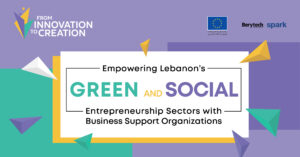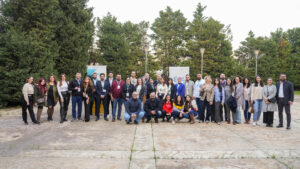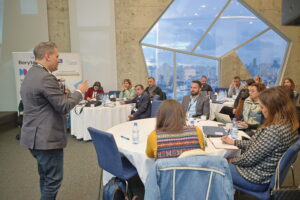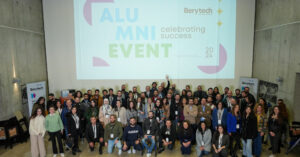The past couple of years have proven the need and value of what lies in our bins: waste that can be turned into accessible raw material or sold for profit. Despite this fact and the many private efforts put forward in the waste management sector, recycling is still not integrated into our daily lives, and proper waste management systems are far from being implemented.
We talk to Samar Khalil, an expert in waste management and an activist in civil society organizations pushing for sound environmental policies for recycling in the country and driving awareness on the value of our recyclables, and the path to a circular economy.
Q: How can recycling provide a new revenue stream for local companies, knowing that scrap metal is already a top-ranked product in Lebanon’s exports chart?
A: Recycling is one important component in the waste hierarchy and circular economy as it is one way to recover materials and keep them in the economy as much as possible. Some studies conducted at the national level showed that the potential recycling business turnover is between $US 65 million and $US 272 million per year. However, due to improper waste sorting and recovery, it is estimated that 64 million USD are lost per year in material loss from e-waste, 0.55 million USD cost recovery from beer bottles, 2.6-21.81 million USD cost recovery from paper waste, USD 100 million lost per year in unused energy and nutrients from organic waste.
On another note, proper waste management including recycling can create between 1,900-2,500 new jobs over 9 years.
Q: What is Lebanon’s main recyclables and how are they being processed?
A: Main recyclables collected in Lebanon are plastics, paper, and metals in addition to organic waste, glass, e-waste, and tires to a lesser extent. Many plastic recycling industries recycle plastics into different forms and products including plastic waste flakes and pellets, consumer products like hoses, boxes (crates), construction material (spacers), etc.
Paper and cardboard are recycled in national industries into recycled paper and cardboard. Metals are mainly exported abroad for recycling. Glass is recycled by traditional glass blowers and one industry in Tripoli. As for tires, the metal part is recovered whereas the rubber part is shredded to make rubber tiles or flakes to be used in sports courts.
E-waste is collected and refurbished, when possible, to be reused again or dismantled to recycle plastic and metals, and electronic parts are exported for recycling abroad.
Organic waste is composted or biologically treated to produce compost to be used in agriculture.
Q: What are the main challenges for initiatives currently collecting recyclables?
A: Challenges for collecting recyclables include:
- No sorting at source.
- No separate collection of waste.
- Hazardous waste is mixed with municipal waste.
- Increased fuel costs for transportation.
Q: With the emergence of all these initiatives about collecting recyclables, isn’t it better that all efforts are consolidated?
A: Consolidating efforts should bring benefits to all these initiatives as they can create economies of scale and reduce cost while improving efficiency and broadening the geographical span of operations.
Q: What stops people from sorting their waste? And what are the models that could be successfully implemented to reverse that?
A: Several factors might prevent people from sorting including:
- Lack of awareness of the importance of sorting.
- Lack of infrastructure for sorting (separate bins and separate collection).
- Lack of trust in authorities or entities collecting recyclables.
- Lack of incentives.
To promote sorting at source, authorities should increase people’s awareness of its importance, provide the necessary infrastructure and logistics for sorting and separate collection, be transparent and report the quantities of recyclables collected, their destinations and generated revenues, and provide incentives (collection of points to be redeemed, cash back, tax exemption, etc.) or disincentives (fines, warning, etc.) for sorting at source.
Q: What are the main challenges faced by sorting facilities?
A: There are many challenges faced by sorting facilities:
- Low efficiency and quality of sorting
- No sorting at source and mix of hazardous waste with municipal waste.
- Use of compactor trucks that reduce sorting efficiency.
- Low and inconsistent quality of the sorted recyclables.
- The absence of advanced technology in sorting facilities to reduce errors in sorting.
- Lack of product design for recycling.
- Lack of infrastructure and technology for recycling certain types of waste.
- High energy cost.
- Lack of industry-wide best practices for recycling e.g., safely extracting valuable metals from e-waste, in ways that minimize environmental damage.
- Lack of quality standards for inputs and outputs from recycling industries.
- Lack of technical training and business development support for repairers/recyclers to improve repair/recycling quality and expand their business.
- Absence of a marketplace that links consumers to recyclers and other players in the value chain.
- Absence/scarcity of online platforms for sourcing and re-sale of materials.
- Lack of financial incentives for sorting and recycling.
- Absence of legislation to control the use of toxic/hazardous additives in materials which hinders their recyclability.
- High cost of the fuel to transport recyclables.
- Price volatility of recyclable wastes compared with virgin materials e.g., plastics.
- Most sorting facilities are not run with profitability as the main objective, most cost recovery seems to be achieved through subsidizing waste collection and sorting, either through charging a fee for waste pick-up per household or through payment of municipal fees funded through taxes.
Q: What are the technological solutions needed to make sorting and recycling a more achievable reality?
A: Many solutions could be implemented; some are simple and some require better policy or innovation:
- Sorting at source and separation of collected waste can enhance the efficiency and quality of recycling.
- Sorting facilities should be equipped with better and more advanced technology to reduce errors in sorting – such as Near Infrared (NIR) Sorting –
- Creating a marketplace to connect entities that collect recyclables with recycling facilities.
- Providing incentives to reduce energy costs for sorting and recycling industries.
- Providing industry-wide best practices for recycling e.g., safely extracting valuable metals from e-waste, in ways that minimize environmental damage.
- Developing quality standards for inputs and outputs from recycling industries.
This article is published under the Diverting Waste by Encouraging Reuse and Recycling (DAWERR), a five-year activity funded by the United States Agency for International Development (USAID) with the goal to establish sustainable and replicable integrated solid waste diversion and valorization solutions in rural areas. of Lebanon.
About the Author
Samar Khalil is an environmental management specialist with 19+ years of experience in integrated environmental management, including waste management. She has a deep knowledge of national environmental policies and regulations and sectoral knowledge of regional regulations, after having worked in Lebanon and the region—including Jordan, Syria, and Tunisia—over the past two decades. She is actively working with civil society organizations pushing for sound environmental policies.








